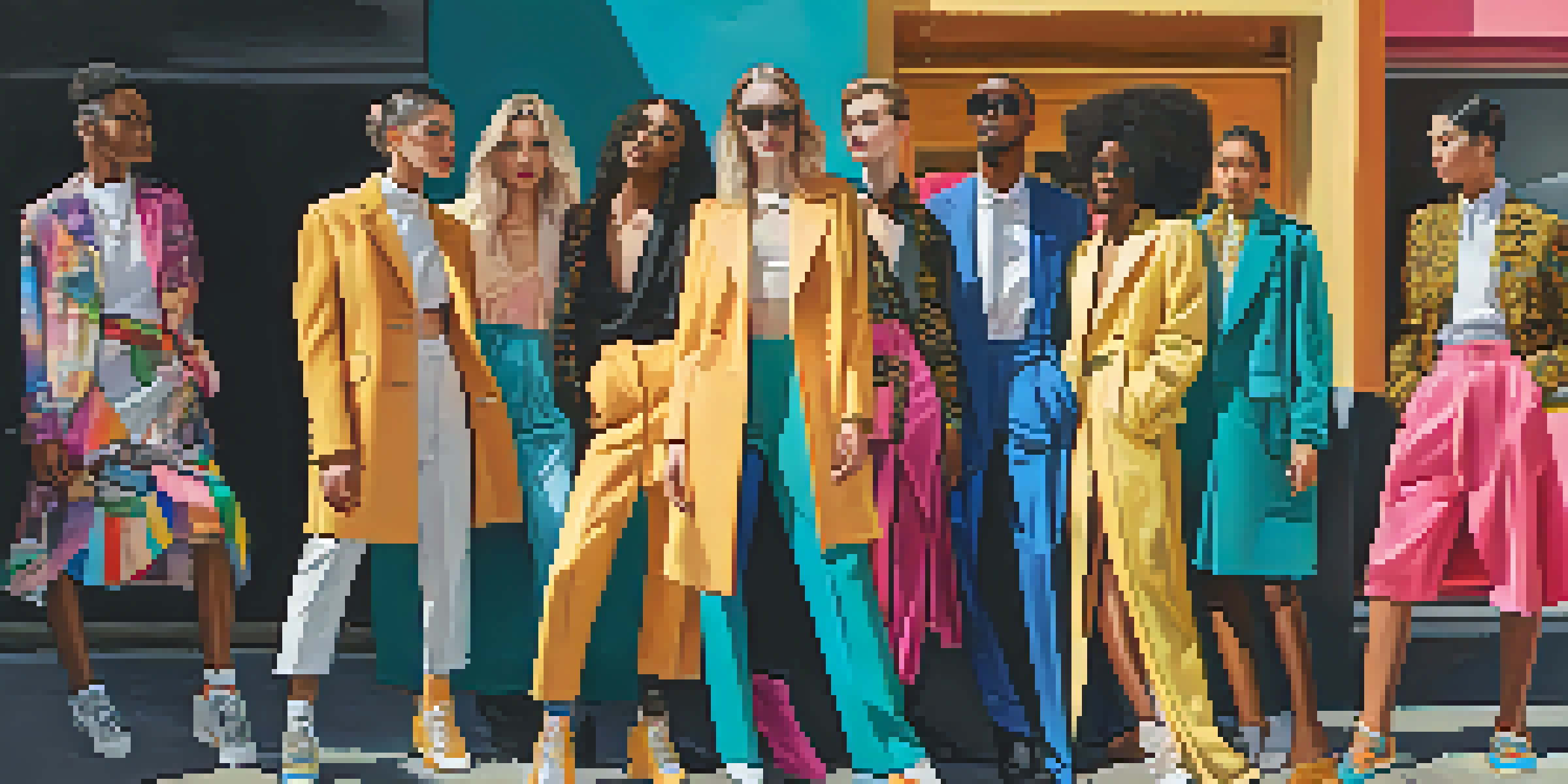Exploring Gender Fluidity in Contemporary Fashion Design Trends

Understanding Gender Fluidity in Fashion Context
Gender fluidity refers to the concept that gender is not strictly binary; it can be a spectrum. In fashion, this means breaking away from traditional gender norms and embracing a more inclusive approach to clothing design. Designers are increasingly creating collections that cater to individuals regardless of their gender identity, allowing for a more personal expression of style.
Gender is a spectrum, not a binary. It allows us to explore who we are beyond conventional labels.
This shift is not just about clothing; it's about challenging societal expectations. When designers use gender fluidity as a guiding principle, they open up a dialogue about identity and self-expression. It encourages people to explore who they are beyond conventional labels.
For instance, brands like Telfar and Gucci have been at the forefront of this trend, showcasing designs that appeal to all genders. This forward-thinking approach helps to normalize the idea that fashion can be for everyone, regardless of gender.
The Evolution of Gender-Neutral Fashion
Gender-neutral fashion has its roots in the 1960s and 70s, but it has gained significant momentum in recent years. The rise of unisex clothing lines marks a departure from the restrictive categories of 'men's' and 'women's' wear. Today, many brands offer collections that encourage individuals to wear what feels right for them, without labels.

This evolution reflects broader societal changes as more people identify as non-binary or genderqueer. Fashion designers are responding to this shift by creating pieces that can be styled in various ways, emphasizing versatility and personalization. The goal is to empower individuals to express their unique identities.
Fashion Embraces Gender Fluidity
Designers are increasingly creating collections that break traditional gender norms, allowing for personal expression beyond conventional labels.
For example, brands like ASOS and Zara have introduced gender-neutral sections in their stores, making it easier for shoppers to find clothing that resonates with their personal style. This approach not only attracts a diverse customer base but also fosters a sense of community among those who may feel marginalized by traditional fashion.
Influence of Pop Culture on Gender Fluidity
Pop culture plays a significant role in shaping fashion trends, and gender fluidity is no exception. Celebrities like Billy Porter and Harry Styles have made headlines for their bold fashion choices that defy gender norms. Their public personas challenge traditional ideas of masculinity and femininity, inspiring fans to embrace a more fluid approach to dressing.
Fashion is the armor to survive the reality of everyday life.
These cultural icons are not just setting trends; they are sparking conversations about identity and self-expression. Their influence has led to a greater acceptance of gender fluidity in mainstream fashion, encouraging designers to think outside the box. As a result, we see more innovative and daring designs that cater to a diverse audience.
Moreover, music and film are increasingly showcasing characters who embody gender fluidity, further normalizing this concept. This visibility is crucial in helping individuals feel represented and validated in their choices, ultimately driving demand for more inclusive fashion options.
Sustainable Fashion and Gender Fluidity
Sustainability has become a hot topic in fashion, and it intersects interestingly with gender fluidity. Many brands are now focusing on creating timeless pieces that transcend gender and trends, promoting a more sustainable approach to clothing consumption. This shift encourages consumers to invest in quality items that can be worn by anyone, reducing waste in the fashion industry.
By designing gender-neutral clothing, brands can also streamline their production processes. Fewer categories mean less inventory and ultimately, less environmental impact. This approach aligns with the values of many consumers who are becoming increasingly aware of their purchasing decisions.
Pop Culture Drives Fashion Change
Celebrities challenging gender norms have sparked wider acceptance of gender fluidity in fashion, influencing both designers and consumers.
For example, companies like Reformation and Everlane are leading the charge in sustainable fashion while embracing gender fluidity. Their commitment to eco-friendly practices and inclusive designs appeals to a conscientious audience, demonstrating that fashion can be both responsible and expressive.
The Role of Social Media in Promoting Gender Fluidity
Social media platforms have become powerful tools for promoting gender fluidity in fashion. Influencers and content creators share their personal stories and style choices, helping to normalize diverse expressions of gender. This visibility fosters a sense of community and encourages others to explore their own identities through fashion.
Platforms like Instagram and TikTok allow users to showcase their unique styles, breaking down traditional boundaries in the process. Hashtags such as #GenderFluid and #UnisexFashion have gained traction, creating a space for discussions and visibility around gender nonconformity.
Moreover, brands are leveraging social media to connect with their audience and promote gender-neutral collections. This strategy not only enhances brand loyalty but also cultivates a supportive environment where individuals feel free to express themselves authentically.
Challenges and Criticisms in Gender Fluid Fashion
While the rise of gender fluidity in fashion is promising, it is not without its challenges and criticisms. Some argue that the mainstreaming of gender-neutral clothing can sometimes dilute the authenticity of the movement. When large corporations jump on the bandwagon, it raises questions about whether they genuinely support gender fluidity or are simply capitalizing on a trend.
Additionally, there is a risk that gender fluid fashion may become overly commercialized, losing its essence in the process. The challenge lies in ensuring that the voices of marginalized communities are not overshadowed by corporate interests. Authentic representation is crucial for maintaining the integrity of the movement.
Sustainability Meets Inclusivity
The focus on sustainable fashion aligns with gender fluidity, promoting timeless pieces that reduce waste and appeal to diverse identities.
As consumers, it's essential to stay informed and support brands that prioritize inclusivity and authenticity. By doing so, we can encourage a fashion landscape that genuinely reflects the diversity of gender identities and expressions.
The Future of Gender Fluidity in Fashion Design
Looking ahead, the future of gender fluidity in fashion design appears bright. As society continues to evolve, so too will the fashion industry, with designers increasingly embracing diverse identities. The ongoing dialogue about gender and fashion is likely to influence future collections, leading to even more innovative and inclusive designs.
Emerging designers are already pushing boundaries and challenging conventions, often prioritizing gender fluidity in their work. This fresh perspective is essential for creating a fashion landscape that reflects a broader range of human experiences and identities. It's exciting to think about how these new voices will shape the industry.

Ultimately, the future of fashion is about empowerment and expression. By embracing gender fluidity, designers and consumers alike can contribute to a more inclusive environment where everyone feels seen and valued. The journey towards a more equitable fashion industry is just beginning, and it will be fascinating to witness its evolution.